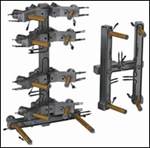When Is Lean Too Lean?
When it comes to lean manufacturing, how and when do you know if you have struck your perfect balance?
When it comes to lean manufacturing, how and when do you know if you have struck your perfect balance?
I’ve looked at situational designs, and customer service scenarios, and began to question, can a company become too lean? Lean to a point where the final product begins to suffer. Truth is, for a company to operate with optimum efficiency, some departments within that company need to be inefficient.
Mold manufacturers need to ask themselves some simple questions: What got you where you are in the first place? Is it your product, your service, your technology? Maybe it is all of the above? The point is your customers came to you because you offered something that someone else could not or did not want to supply them. Becoming lean can have an ugly habit of making a company lose its identity.
I’m not saying to stay fat and inefficient, but when do you know you have gone too far? Lean needs to be more than just cutting costs, it needs to be about continuous improvement, and most importantly, it needs to be about balance. The right balance of cost to our customers, and quality of product and service that our customers have grown to expect.
Before a lean operation is implemented, the following questions should be answered with a resounding Yes!: (1) Will the lean idea increase efficiency? (2) Will it help me to reduce manufacturing costs, and allow me to be more competitive in the marketplace? (3) Will it improve my product or service? and (4) has it been conceptualized so that quality, longevity and performance are not compromised?
Apart from answering yes to the above, value-added services—program management, warranty, and repair and maintenance programs—are keys to the lean balance. It’s great to be able to improve shop efficiency, but your customer cannot be allowed to suffer. This is where the one company inefficiency needs to exist. Your customer service people represent a good portion of the company’s overhead expense, but without that your customer becomes disconnected from you and becomes a victim to your competition.
We can’t allow ourselves to cut so much from the product that it loses its integrity. I understand cost points, market prices and offshore competition, but I also understand balance, volume and capability.
Related Content
-
Editorial Guidelines: Editorial Advisory Board
The Editorial Advisory Board of MoldMaking Technology is made up of authorities with expertise within their respective business, industry, technology and profession. Their role is to advise on timely issues, trends, advances in the field, offer editorial thought and direction, review and comment on specific articles and generally act as a sounding board and a conscience for the publication.
-
Predictive Manufacturing Moves Mold Builder into Advanced Medical Component Manufacturing
From a hot rod hobby, medical molds and shop performance to technology extremes, key relationships and a growth strategy, it’s obvious details matter at Eden Tool.
-
Women Impacting Moldmaking
Honoring female makers, innovators and leaders who are influencing our industry's future.















